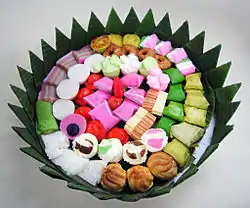Kue putu mangkok
Kue putu mangkok, kueh tutu, kue putu ayu, or putu piring is a round-shaped, traditional Indonesian steamed rice flour kue or sweet snack filled with palm sugar, and commonly found in Indonesia, Singapore, Malaysia, and Southern Thailand. It is usually made using stainless steel molds with a distinctive flower shape. The Indonesian kue putu mangkok and Singaporean kueh tutu tend to be thicker and rounder, while putu piring from Malaysia and Southern Thailand tend to be flatter with a disc-like shape. Its composition is quite similar to the cylindrical kue putu or putu bambu, which are steamed using bamboo tube containers instead.
 Kue putu mangkok or kueh tutu in Singapore | |
| Alternative names | Putu piring, kue putu ayu, kueh tutu |
|---|---|
| Type | Sweet dumpling |
| Course | Dessert |
| Place of origin | Indonesia |
| Created by | Derived from Indian puttu |
| Serving temperature | Commonly served with bamboo leaves and sweet sauce. |
| Main ingredients | Rice flour or glutinous rice flour, filled with ground peanuts and sugar, or shredded coconut |
| 56 with coconut filling[1] = 64 with peanut filling[2] kcal | |
| Similar dishes | Mont baung |

The Burmese counterpart, called mont baung (မုန့်ပေါင်း), is comparably larger in size and is filled instead with jaggery or red beans and garnished with coconut shavings.[3]
Ingredients
Kue putu mangkok is made primarily from finely pounded rice flour or glutinous rice flour, and contains fillings of either ground peanut or brown palm sugar mixed with shredded coconut. The typical preparation method involves rapid steaming of both the flour and the filling. Once ready, it is served on pandan leaves to give it a sweet flavor and scent.
In the 1980s, the invention of special steam carts and stainless steel molds for making kueh tutu helped to popularize this street snack in Singapore, and saw many kueh tutu outlets selling it in many major supermarkets.[4]
Cultural Impact
Putu Piring was also featured on the Netflix TV series, Street Food (TV series) in season 1.[5]
See also
References
- "My Fitness Pal".
- "My Fitness Pal".
- "မြန်မာ့ရိုးရာအစားအစာ မုန့်ပေါင်း". Mizzima Myanmar News and Insight. Retrieved 2019-11-13.
- "Kuih tutu". Singapore Infopedia.
- Tan, John (25 April 2019). "Local putu piring stall featured in new Netflix show Street Food". SPH Digital News. The New Paper. Retrieved 29 July 2020.
